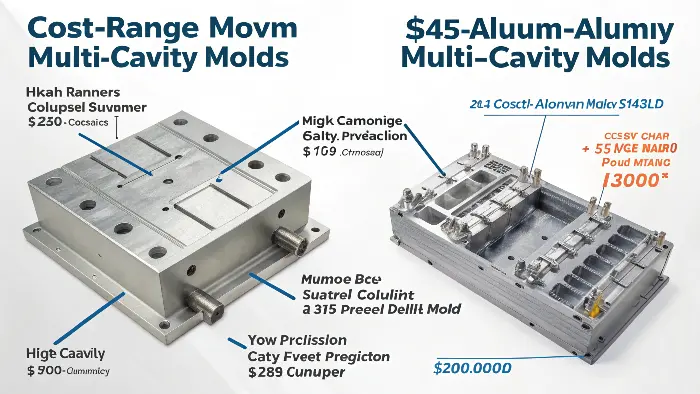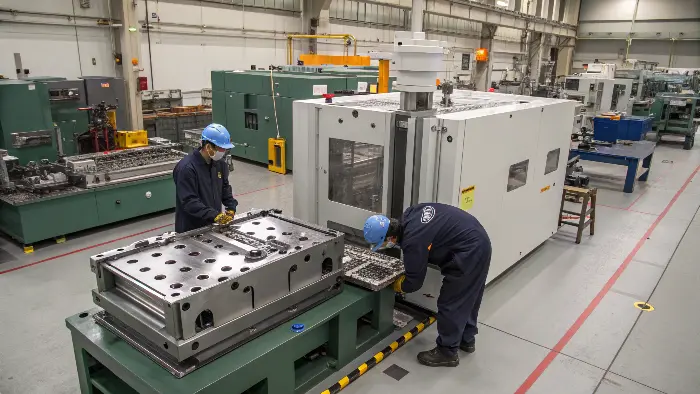Struggling to scale production efficiently? Multi-cavity and family molds offer solutions, but choosing correctly is vital. Let’s explore how.
Multi-cavity molds produce multiple identical parts per cycle, while family molds create a set of different but related parts. The key is selecting the right approach by balancing design complexity, tooling investment, and production performance against your specific manufacturing needs.
I’ve seen many clients grapple with the decision between multi-cavity and family molds. Both are powerful tools for increasing output in injection molding, but they serve different purposes and come with unique considerations. Understanding these differences is the first step towards making a smart investment that aligns with your production goals and budget. As we say at CKMOLD, "Master Molding Right," and that starts with choosing the right tool for the job.
What Is the Difference Between a Family Mold and a Multi-Cavity Mold?
Confused about family versus multi-cavity molds? One makes identical parts, the other makes a set. Knowing the difference is crucial for efficient production.
A multi-cavity mold produces many identical parts in a single shot. A family mold produces a set of different parts, typically components of a single assembly, in one shot. The choice impacts consistency, cycle time, and cost.
When I first started in this industry, the distinction seemed subtle, but its impact is huge. Let’s break it down:
Multi-Cavity Molds
These molds are designed with two or more cavities that are geometrically identical.
- Purpose: To produce a high volume of the same part rapidly. Think bottle caps, electrical connectors, or small gears.
- Advantages: High output rate, lower per-part cost in mass production, consistent part quality (as all cavities are identical).
- Considerations: Requires precise balancing of runner systems to ensure all cavities fill equally. Higher upfront tooling cost than a single-cavity mold, but this is offset by volume. Jacky, aiming for large-scale production, would often lean towards these for individual components.
Family Molds
These molds contain two or more cavities that produce different parts. Usually, these parts form an assembly. For example, the front and back housing of a small electronic device.
- Purpose: To produce all components for a single product assembly in one molding cycle.
- Advantages: Reduces inventory (all parts for an assembly are made together), can be cost-effective for lower volume assembled products, simplifies logistics.
-
Considerations: Balancing the flow and fill for parts of different sizes, volumes, and geometries within the same mold is a significant design challenge. If one part has an issue, the whole shot might be scrap. Cycle time is dictated by the part that takes the longest to cool. I remember a tricky family mold for a remote control; getting the battery cover and the main housing to mold perfectly with different wall thicknesses was a real test of our design skills. Feature Multi-Cavity Mold Family Mold Parts Produced Identical Different (usually an assembly set) Main Goal High volume of one part Complete set of parts per shot Runner Balance Critical for consistency Very complex, critical for quality Typical Use Mass production, single components Assembled products, lower volumes Choosing between them requires a clear understanding of your production volume, part assembly needs, and budget.
How Much Does a Multi-Cavity Mold Cost?
Wondering about multi-cavity mold costs? They vary widely based on complexity. More cavities and features mean a higher initial investment.
A multi-cavity mold can range from a few thousand dollars for a simple, 2-cavity aluminum prototype mold to hundreds of thousands for a high-precision, 64+ cavity steel production mold with hot runners.

There’s no simple answer to "how much?" because so many factors influence the price. I always tell clients that a mold is an investment, and the cost reflects its engineering and longevity. Here are the main drivers for multi-cavity mold costs:
- Number of Cavities: This is a primary driver. More cavities mean more steel, more machining time, and a more complex mold base and runner system. A 32-cavity mold will be significantly more expensive than a 4-cavity mold for the same part.
- Part Complexity: Intricate part designs with undercuts, threads, or very tight tolerances require more complex mold mechanisms (like sliders, lifters, or unscrewing devices), which add substantially to the cost. Jacky often deals with such complex parts for consumer electronics.
- Mold Material:
- Aluminum: Cheaper, good for prototyping or low-volume runs.
- Pre-Hardened Steel (e.g., P20): A common choice for medium-volume production, offering a good balance of cost and durability.
- Hardened Steel (e.g., H13, S7): Most expensive, used for high-volume production and abrasive materials, offering the longest mold life.
- Runner System:
- Cold Runner: Less expensive initially, but generates material waste.
- Hot Runner: Higher upfront cost but saves material, reduces cycle times, and can improve part quality, especially for multi-cavity setups. For high-volume, the long-term savings often justify the cost.
- Tolerances and Surface Finish: Higher precision and polished/textured finishes require more skilled labor and advanced machining, increasing costs.
- Mold Size: Larger parts naturally require larger, more expensive molds.
I once quoted a 16-cavity mold for a client. The initial price seemed high, but when we broke down the per-part cost over a million cycles, considering material savings from a hot runner system, it was clearly the most economical path.How To Calculate Mold Cost?
Trying to budget for a new mold? Mold cost calculation involves materials, design, machining, assembly, and tryout. Understanding these elements helps.
Mold cost is calculated by summing expenses for design/engineering, raw materials (steel, components), machining (CNC, EDM, grinding), mold assembly/fitting, and initial tryouts/sampling. Overhead and profit margin are also factored in.

Calculating mold cost isn’t just about adding up steel prices. It’s a detailed process. When I work on a quote for a client, whether it’s for Jacky’s company or a smaller startup, I consider several key areas:
1. Design and Engineering Costs
This covers the hours spent by skilled designers and engineers to:
- Analyze the part design for manufacturability (DFM).
- Design the mold layout (cavity placement, runner system, cooling, ejection).
- Create detailed 2D and 3D CAD models of the mold.
- Perform mold flow analysis if necessary.
The complexity of the part and mold heavily influences this cost.2. Material Costs
This includes:
- Mold Base: Standardized or custom, made from specific steel grades.
- Cavity/Core Steel: P20, H13, S136, etc., chosen based on production volume and part material.
- Standard Components: Ejector pins, guide pins, bushings, screws, heating elements (for hot runners), hydraulic cylinders, etc.
3. Machining and Labor Costs
This is often the largest component. It involves various processes and the skilled labor to operate them:
- CNC Milling: For shaping cavities, cores, and mold base components.
- EDM (Electrical Discharge Machining): For intricate details, sharp corners, and deep ribs.
- Grinding: For achieving precise dimensions and surface finishes.
- Polishing: For achieving desired surface quality on the molded parts.
4. Assembly and Tryout Costs
- Mold Assembly: Skilled toolmakers carefully assemble all the machined components.
- Fitting and Benchwork: Ensuring all moving parts function smoothly.
- Tryout (Sampling): Running initial shots to test the mold, verify part dimensions, and make any necessary adjustments. This often involves several iterations.
5. Overhead and Profit
Like any business, mold makers have overheads (rent, utilities, administrative costs) and need to include a profit margin.
I always try to be transparent about these components so clients understand the value they are getting. A well-built mold is a precision instrument designed for longevity.Why Do Injection Molds Cost So Much?
Shocked by mold prices? Molds are precision-engineered tools, built from robust materials by skilled experts to withstand immense pressures repeatedly.
Injection molds are expensive due to the high-precision engineering, durable hardened steel materials, complex machining processes (CNC, EDM), skilled labor for design and assembly, and the need for them to withstand millions of cycles under high pressure and temperature.

It’s a common question I hear: "Why are injection molds so expensive?" Especially when clients are new to plastic manufacturing. The truth is, a production mold is a highly sophisticated piece of custom-built machinery, not just a simple block of metal. Here’s a breakdown of why they command a significant investment:
- Precision Engineering: Molds must produce parts with tolerances often measured in thousandths of an inch (or hundredths of a millimeter). This requires extremely precise design and manufacturing. Think about Jacky, who needs parts to fit perfectly in consumer electronics assemblies – any deviation can cause major problems.
- Durable Materials: Molds are typically made from high-quality, hardened tool steels. These materials are expensive but necessary to withstand the immense pressures (often thousands of PSI) and temperatures of injection molding, and to last for hundreds of thousands, or even millions, of cycles.
- Complex Machining: Creating the intricate cavities, cores, cooling channels, and ejection systems involves advanced and time-consuming machining processes like CNC milling, EDM (Electrical Discharge Machining), and precision grinding. These machines are expensive, and operating them requires skilled technicians.
- Skilled Labor: Designing a mold that works efficiently and reliably requires experienced mold designers. Building, assembling, polishing, and testing the mold requires highly skilled toolmakers. This expertise comes at a cost.
- Customization: Every mold is custom-designed for a specific part. There’s no "off-the-shelf" production mold. This bespoke nature contributes to the cost.
- Integrated Systems: Modern molds often include complex cooling systems for cycle time optimization, intricate ejection mechanisms, and sometimes hot runner systems, all of which add to the complexity and cost.
When you consider that a single mold might produce millions of parts over its lifetime, the upfront cost, when amortized per part, often becomes very reasonable. It’s an investment in reliable, high-volume production.Conclusion
Choosing multi-cavity or family molds involves balancing initial cost, part complexity, and production volume. Understanding these factors ensures optimal and cost-effective manufacturing for your specific needs.
